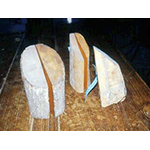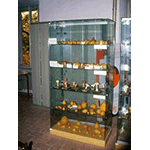Orto Botanico Comunale di Lucca - Museo Botanico "Cesare Bicchi" [Public Botanical Garden of Lucca - "Cesare Bicchi" Botanical Museum]
In an urban context of the city, the Botanical Garden of Lucca develops over a surface area of about two hectares. It was created in 1820 during the government of the Duchess Marie Louise of Bourbon, recovering a pre-existing plan drafted during the Napoleonic principality. In September 1843 – as recalled by a plaque – the premises of the Garden were used for the meetings of the botanists who participated in the Fifth Congress of Italian Scientists. The Garden considerably developed between 1860 and 1907 under the direction of Cesare Bicchi. At that time, today’s greenhouses were built, along with the lake, and numerous live plants and dry materials were added. After World War I, the Garden was neglected and practically abandoned, and recovered in 1956 under the direction of the holder of the chair of Natural Sciences of the Liceo Classico "Machiavelli". The past twenty years have returned attention to the officinal species, reviving an ideal relationship with the old private botanical gardens of the city, which today no longer exist.
The Garden of Lucca, like those of Pisa, Florence, and Siena, is one of the still active old Tuscan botanical gardens. It is divided into various sectors: the arboretum mainly includes exotic trees and shrubs; the lake also contains local fauna; more than two-hundred species of heath grow in two beds; the ferns are being organised; the hillock is the site of Luccan and Pisan mountain species; spontaneous species for food use; medicinal plants; the greenhouses have numerous species from the intertropical regions; the spermoteca has a collection of seeds for exchange with other botanical gardens.
The Cedar of Lebanon (Cedrus libani) with its more than 6 metre circumference, 22 metre height, and a crown that extends for some 500 square metres, is the most important tree in the Garden and, as such, is considered its symbol. It was planted in 1822 by Paolo Volpi, the first director of the Garden of Lucca.
Adjoining the Garden is an interesting Botany Museum, founded in 1985 and named after Cesare Bicchi. The main nucleus is made up of herbaria created by the early directors. The Herbarium Lucensis was born with the collections of Benedetto Puccinelli, director of the Garden from 1833 to 1850. Towards the end of the 19th century, it was considerably increased with the acquisition of the personal herbarium of Cesare Bicchi. The main collections include the Flora Lucensis Exsiccata of Puccinelli, the Herbarium Bicchianum and the Erbario Anonimo C of the 18th century.
The Museum also conserves other interesting collections: the collection of plants and wood, with samples of trunks of various tree species, sectioned longitudinally; a pomological collection consisting of plaster models of fruit cultivated in the Lucca countryside in the 18th and 19th centuries; a mycological collection with plaster models of macro fungi that can be dated to the early 20th century; a collection of farm machine models (ploughs, sowers, spades and hoes) in wood and metal, donated by the Provisional Government of Tuscany in 1859.
The learning laboratory and that of plant preparation are situated near the Barracks on the city walls. The Garden and Museum are today managed by the Walls Authority of Lucca.
****************************
Texts by Graziano Magrini
English translation by Victor Beard
Last update 23/feb/2009





